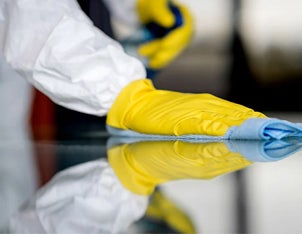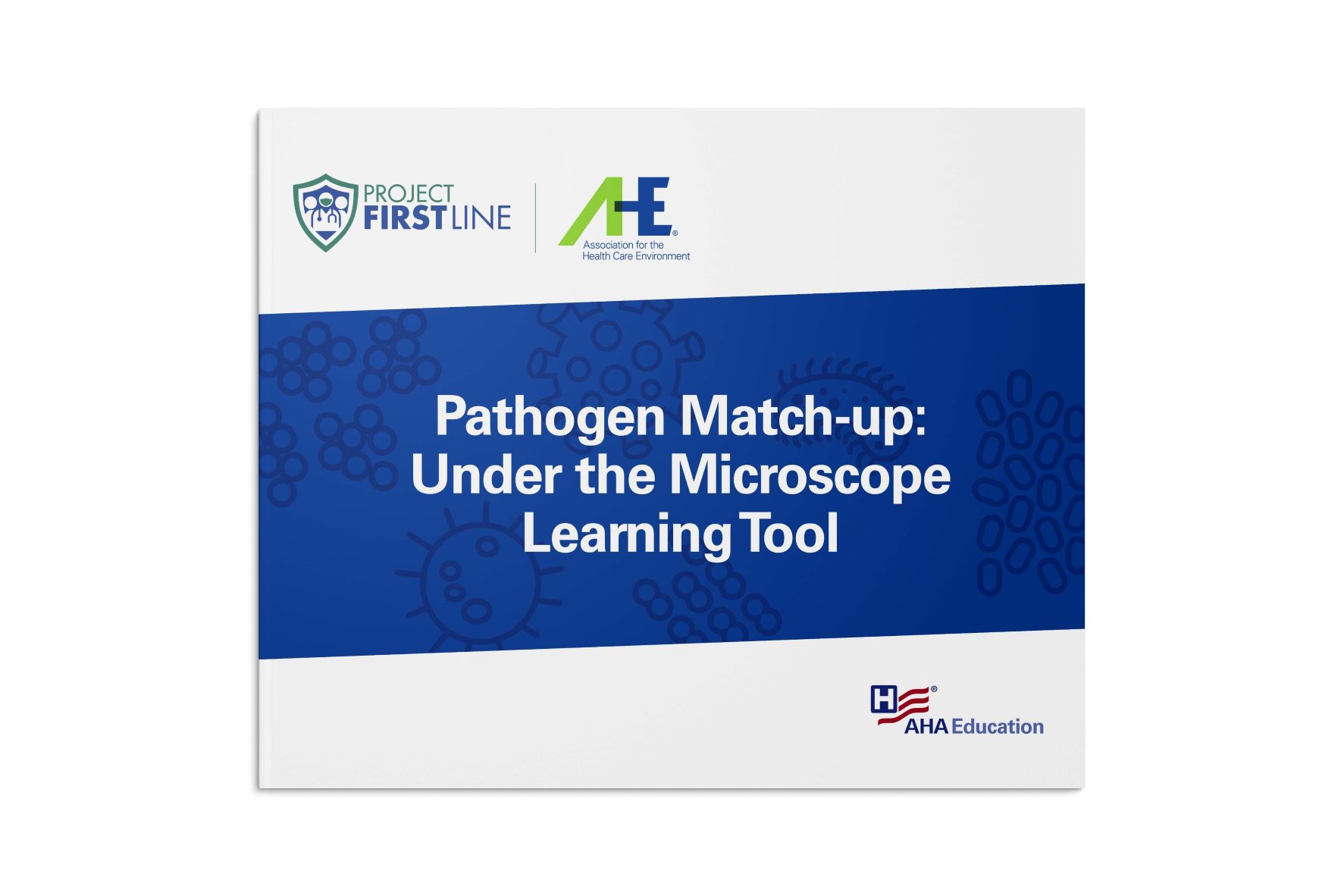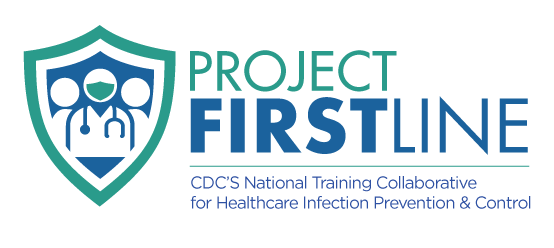
Project Firstline
An Infection Prevention and Control Training Collaborative
Project Firstline is a CDC national training collaborative offering timely infection control training to front line health care workers and the public health workforce in the fight against infectious disease threats. As a key partner in this initiative, AHA is pleased to help bring this critical training opportunity to the health care field and champion sound decision-making and positive behaviors in a time of crisis.
To stop the spread of infectious disease threats—including COVID-19—anyone working in a health care facility needs a foundational knowledge of infection control and must understand and be ready to implement infection control protocols and procedures throughout their work day, including during every patient care activity and health care interaction.
AHE is pleased to contribute to this critical education and training opportunity and offer resources supporting health care environmental services professionals in their commitment to a pathogen-free healing environment across all care settings.
Share this page with your manager and other health care front line professionals, and let them know they can follow Project Firstline on Facebook and Twitter for the latest information about upcoming resources and events.
EVS Competency Resource Search Tool
Build or enhance your skills and grow your careers as you work to reduce the spread of infection in the health care setting.
EVS Fact Webpage
Get talking points and information about the health care profession and the vital role EVS technicians play.
EVS Front-line Educational Videos - Available in Spanish!
A series of explainer videos that support EVS professionals in their efforts to practice proper cleaning and disinfection in a variety of health care settings.
EVS Cleaning & Disinfecting Job Aids
Access the two EVS cleaning and disinfecting job aids for frontline EVS professionals and their supervisors to use in their efforts to practice proper cleaning and disinfection.
Environmental Services -- Keeping It Clean
Episode 1: Why EVS is the First Line of Defense in Infection Prevention and Control
View Transcript
00;00;01;01 - 00;00;27;14
Patti Costello
This podcast is presented by the Project FirstLine program in partnership with the American Hospital Association and its nonprofit affiliates, the Health Research and Educational Trust and the Association for the Health Care Environment. Project Firstline is a national training collaboration led by the Centers for Disease Control and Prevention, offering infection control training in partnership with several health care organizations.
00;00;29;00 - 00;00;44;20
Patti Costello
Hello, I'm Patti Costello, executive director of the Association for the Health Care Environment, or AHE. Welcome to Environmental Services—Keeping It Clean, a limited podcast series for environmental services frontline technicians.
00;00;45;03 - 00;01;22;28
Patti Costello
Environmental services, or EVS, technicians, are the first line of defense in environmental infection prevention and control. You are professionals responsible for establishing and maintaining health care environments that are free of surface contamination. You save lives. This podcast supports your daily efforts to keep your health care facility and the people in it, including yourself, safe from transmission of pathogens or germs that can cause infections. This is episode one, “Why EVS is the First Line of Defense in Infection Prevention and Control.”
00;01;23;09 - 00;01;36;11
Patti Costello
Preventing infection is at the heart of all the duties environmental services teams perform, all day, every day! Today, I will talk about why your role is so critical to patient and worker safety.
00;01;36;24 - 00;01;51;26
Patti Costello
We will also touch on how to clean and disinfect as well as how to protect yourself and others in your daily work. We hope this podcast will reinforce just how important your work is and re-energize how you perform that work.
00;01;52;28 - 00;02;04;02
Patti Costello
As EVS technicians, you are tasked with performing your duties the same way, every day, every time, to ensure the safety of patients, staff, and visitors.
00;02;04;17 - 00;02;17;20
Patti Costello
Understanding WHY this is necessary will help you remember HOW. There are five main items EVS technicians need to learn about the pathogens or the germs that cause infections in a health care setting.
00;02;18;04 - 00;02;47;04
Patti Costello
First, pathogens or germs are likely always present. Second, know where these pathogens live and how they multiply and spread. Third, know how pathogens leave where they live and spread to other areas in a health care facility, including people. Fourth, know how germs can enter the human body. And finally, who is at most at risk of becoming infected.
00;02;47;26 - 00;02;59;25
Patti Costello
There are many kinds of pathogens, and they come in various shapes and sizes. They may be bacteria, molds, viruses, yeasts, other fungi or parasites.
00;03;00;11 - 00;03;44;05
Patti Costello
They are generally invisible to the eye and can remain on a surface, object, or your hands, even when you thought they were clean; often for months! They can also spread quickly, and in many different ways. Some examples of the worrisome pathogens that may be found in a health care facility include Clostridioides difficile or C diff., methicillin-resistant Staphylococcus aureus or MRSA, norovirus, varicella zoster virus which causes shingles and chickenpox, respiratory syncytial virus or RSV, measles, tuberculosis, and SARS-CoV-2, which causes COVID 19.
00;03;44;22 - 00;04;03;14
Patti Costello
Regardless of the pathogen, EVS technicians need to clean and or disinfect all areas as if the worst pathogens are present. Of special concern are bacteria and yeast that have become resistant to antibiotic medications that are meant to kill them.
00;04;03;26 - 00;04;49;14
Patti Costello
They are sometimes called superbugs or MDROs, which stands for multi-drug resistant organisms. They can live on surfaces for a very long time, potentially spreading to other surfaces and people if not removed by proper environmental cleaning and disinfection. We have only briefly touched on this topic here. Please visit the Project Firstline website at www.cdc.gov/projectfirstline to dig deeper into learning more about pathogens. Now that we have covered why infection control is so critical to your role, we will discuss how you need to perform cleaning and disinfection techniques.
00;04;50;05 - 00;05;11;25
Patti Costello
Let's start with the differences between cleaning and disinfection. Cleaning removes visible dirt and debris and makes the surface ready for disinfection. Disinfecting reduces the bioburden, or the number of germs, that are present on surfaces. Cleaning often starts with good old-fashioned rubbing or friction.
00;05;12;10 - 00;05;21;21
Patti Costello
Cleaning using the same pattern each time helps keep you from missing areas. There are four patterns you should always follow.
00;05;22;04 - 00;05;44;22
Patti Costello
One, clean from high to low, or, top to bottom. This prevents dust, dirt, and debris from falling into surfaces you've already cleaned and/or disinfected. Never clean or dust above a patient's head. If you do, a patient can breathe in the dust and dirt. Two, work from clean to dirty.
00;05;44;26 - 00;06;06;16
Patti Costello
Start with the cleanest areas, then move in order to the dirtiest. For example, always clean and disinfect the bathroom last, ending with the toilet and the bathroom floor. Three, clean clockwise or counterclockwise. This means moving in the same directional pattern, either to the right or to the left.
00;06;07;06 - 00;06;16;06
Patti Costello
Four, wipe in one direction. Lift your cloth with each pass on a surface to prevent spreading dirt, dust, or germs.
00;06;16;29 - 00;06;25;12
Patti Costello
Once an area is clean, now it's time to disinfect. Knowing the right disinfectants to use for a situation is critical.
00;06;43;17 - 00;07;08;00
Patti Costello
And I think what's become clear through that time is that's just not the case. We know that that without the data to help us understand where each boat is starting from, we can have no clue as to exactly how much we are closing the gap that now reams of evidence shows exists in health outcomes across various domains of health equity.
00;06;25;27 - 00;06;41;24
Patti Costello
As we mentioned, there are several types of germs and each requires an appropriate, approved level of disinfectant to ensure the disinfection process will inactivate or kill them. There are three categories of
00;06;41;24 - 00;07;03;09
Patti Costello
EPA-approved disinfectants: low, intermediate, and high level. Environmental services will always and only use either low or intermediate-level disinfectants, depending on what germs your facility is most concerned about. In addition to using the right disinfectant, it's important to know
00;07;03;09 - 00;07;30;14
Patti Costello
how to use it correctly. For example, each disinfectant has its own unique wet time. Sometimes you may hear other staff refer to wet time as contact time, or, dwell time. Regardless of the term used, wet time is how long the disinfectant must remain wet on a clean surface to properly inactivate or kill the germs. Your facility will provide
00;07;30;14 - 00;07;50;03
Patti Costello
guidance on what disinfectant to use and where. You can also find a list of EPA-registered products for health care use at cdc.gov. Only EPA-registered products can be used to perform your role in disinfecting. The third item on our agenda today is using the
00;07;50;03 - 00;08;35;17
Patti Costello
correct personal protective equipment, or PPE, to keep us, our colleagues, and our patients safe from the potential spread of pathogens or germs. PPE provides a barrier that keeps our hands, face, nose, eyes and/or clothing protected not just from pathogens but also from harmful chemicals while carrying out our important work. There are two types of precautions that determine when and how to use PPE. First are Standard Precautions which are the minimum infection control practices used during all patient care and services, regardless of whether there's a suspected or confirmed infection present.
00;08;36;10 - 00;08;41;16
Patti Costello
This means you approach all areas as if they're contaminated and act accordingly.
00;08;42;03 - 00;09;11;13
Patti Costello
Consider what task you're about to perform, assess the risk of exposure to potentially harmful pathogens, and choose the PPE that will keep you and the patients safe. Standard Precautions includes things like performing hand hygiene at the appropriate time, using PPE when you might come into contact with contaminated materials such as linen, and using gloves, gowns and other types of PPE appropriate to the task.
00;09;11;23 - 00;09;46;23
Patti Costello
Next are Transmission-Based Precautions. These apply to specific patients who may be infected with a pathogen that requires additional precautions to keep that pathogen from spreading. These precautions are used during each and every encounter with the patient and the patient's environment. The categories of transmission-based precautions are Contact, Droplet, and Airborne. Each category requires specific PPE. Contact precautions prevent the spread of germs through physical contact or touch and always
00;09;46;23 - 00;10;01;12
Patti Costello
requires a gown and gloves. Droplet precautions prevent the spread of germs through close contact with respiratory droplets from coughs, sneezes, or talking. A mask is required for Droplet Precautions.
00;10;01;29 - 00;10;21;17
Patti Costello
Airborne precautions help stop the spread of germs that are much lighter than droplets and travel in the air. A properly fit-tested NIOSH-approved N95 or higher respirator, such as a Power, Air Purifying Respirator or “PAPR”, is required for airborne precautions.
00;10;22;07 - 00;10;41;23
Patti Costello
Always follow your institution's policies and procedures when selecting the proper PPE for transmission-based precautions. Knowing and understanding the purpose of each type of precaution and the required PPE keeps you and our patients safe by reducing the risk of transmission.
00;10;42;05 - 00;11;11;28
Patti Costello
Just as important is knowing which PPE to use and when is knowing the right way to put it on, or don it, and take it off, or doff it. Donning and doffing in the correct order keeps germs from spreading to others in the environment –or to you. Visit cdc.gov for diagrams and instructional videos to see examples of the correct donning and doffing techniques. Thank you for listening. We encourage you to take advantage
00;11;11;28 - 00;11;41;12
Patti Costello
of the other tools Project Firstline and AHE offer, such as videos, posters and infographics, interactive learning activities, and training toolkits. They will build up your knowledge base and start building your career path. The Association for the Health Care Environment provides training resources and a variety of signature programs that help environmental services technicians define and maintain standards in the environment of care.
00;11;41;22 - 00;12;21;21
Patti Costello
Visit the Project Firstline and AHE websites for more information at www.ahe.org and www.ahe.org/project-firstline. ProjectFirstline is a national collaborative led by the U.S. Centers for Disease Control and Prevention to provide infection control training and education to frontline health care workers and public health personnel. AHA is proud to partner with Project First Line as supported through cooperative agreement, CDC-RFA-CK20-2003.
00;12;22;03- 00;12;39;03
Patti Costello
CDC is an agency within the Department of Health and Human Services. The contents of this podcast do not necessarily represent the policies of CDC or HHS and should not be considered an endorsement by the Federal Government.
Episode 2: How to Use the Cleaning & Disinfecting Matrices
View Transcript
00;00;01;04 - 00;00;29;04
Patti Costello
This podcast is presented by the Project Firstline program in partnership with the American Hospital Association and its nonprofit affiliates, the Health Research and Educational Trust and the Association for the Health Care Environment. Project Firstline is a national training collaboration led by the Centers for Disease Control and Prevention, offering infection control training in partnership with several health care organizations.
00;00;29;06 - 00;01;07;28
Jane Martin
Welcome to Environmental Services--Keeping It Clean, a limited podcast series for environmental services, frontline workers, and their supervisors. Environmental Services, or EVS, technicians are the first line of defense in environmental infection prevention and control. We are professionals responsible for establishing and maintaining health care environments that are free of surface contamination. This podcast supports the daily efforts of EVS technicians and supervisors to keep your health care facility and the people in it, including yourself, safe from transmission of pathogens or germs that can cause infections.
00;01;08;01 - 00;01;28;07
Jane Martin
This is episode two: “How to Use the Cleaning and Disinfecting Matrix.” I'm Jane Martin, the Director of EVS Quality and Education at Geisinger Health System. Geisinger is a regional health care provider to central, south-central, and northeastern Pennsylvania, servicing over 3 million patients in 45 counties.
00;01;28;09 - 00;01;42;02
Benjamin Kenyon
And I'm Benjamin Kenyon, the Evening Supervisor for Environmental Services at Saratoga Hospital in Saratoga Springs, New York. Saratoga Hospital is a 171-bed acute care community hospital and part of the Albany Med Health System.
00;01;42;05 - 00;02;04;20
Jane Martin
In any industry, there are checks and balances to ensure safety. For instance, the airline industry uses checklists to make sure the plane takes off, flies, and lands safely. The crew goes through safety checks before they even start to roll on the tarmac. It's no different in health care when we're preparing a space or an environment for someone to receive care.
00;02;04;22 - 00;02;28;10
Jane Martin
Safety is important not only for the patient, but also for us and all of our health care team members. Safety checks help us ensure all items and surfaces are cleaned and disinfected properly and no items or surfaces are skipped or missed. We need to have checklists, matrices or other job aids or resources to make sure the spaces where people are treated are safe.
00;02;28;12 - 00;02;35;23
Jane Martin
Remember, as an EVS professional, you ARE the first line of defense in infection prevention and control.
00;02;35;25 - 00;03;02;19
Benjamin Kenyon
Today we are introducing two new job aids that review cleaning and disinfecting in an easy-to-use matrix format. They are meant to be used as a reference tool for supervisors and frontline team members during day-to-day activities, in particular helping you prepare before you enter different isolation precaution rooms. They both include a matrix of commonly found pathogens or germs, isolation categories, and the different cleaning products to use.
00;03;02;21 - 00;03;16;07
Benjamin Kenyon
They explain at a glance not only what things to consider, but why they are important. Not only are these tools designed to help EVS technicians and supervisors, they're also meant to help your colleagues understand why you clean certain rooms the way you do.
00;03;16;09 - 00;03;40;23
Jane Martin
The first tool we'll discuss is the “Cleaning and Disinfecting Matrix,” a guide for environmental services and other health care workers. This tool is designed for EVS technicians. It can be printed in laminated for easy reference on the EVS card or in the EVS closet. It can also be accessed and viewed online on mobile devices. The Cleaning and Disinfecting matrix is a two-page document.
00;03;40;26 - 00;03;56;04
Jane Martin
The first page lists out important things to consider, including what to think about before entering a patient environment and before beginning to clean and disinfect. It also provides some reminders of what to do while cleaning and disinfecting the areas.
00;03;56;06 - 00;04;19;29
Benjamin Kenyon
The matrix is on the second page. This offers a quick view of some commonly found pathogens in health care settings and how to protect yourself and others by avoiding cross-contamination. It also explains the essentials or the whys behind why it's important to clean and disinfect with certain products and not others. Let's walk through a common scenario. As an EVS technician, imagine that you need to clean a patient room.
00;04;20;01 - 00;04;45;24
Benjamin Kenyon
When you get to the room, you see that it has a “Contact Precautions” sign on the door. At this point, you consult the Cleaning and Disinfecting Matrix on your EVS cart. On page two, you see “Contact Precautions” in the first row. In the first column you see various reminders about how to protect yourself and avoid cross-contamination while cleaning: wearing the correct PPE, performing hand hygiene, and using the appropriate facility-approved disinfectant.
00;04;45;26 - 00;04;55;08
Benjamin Kenyon
The second column has a list of potential pathogens that may be in the room you are about to clean, such as C. diff, MRSA, RSV, or C. auris.
00;04;55;10 - 00;05;17;23
Jane Martin
The last column addresses the reasons why we take additional steps or wear certain PPE while cleaning and disinfecting a contact isolation room. For example, why should you be mindful of how you are about to clean this room?
00;05;17;25 - 00;05;48;25
Jane Martin
Because some germs that spread by touch can survive on surfaces for hours, days, and even weeks if the surfaces aren't properly cleaned and disinfected. Why is certain PPE required before entering the room and why is hand hygiene needed? Many germs, including multidrug resistant organisms or MDROs, are easily transferred from hospital surfaces to health care workers’ hands, which we know can lead to germs spread in a facility and can lead to people getting sick.
00;05;48;28 - 00;06;01;26
Jane Martin
Why do you need to make sure you use the correct facility-approved chemical? Some of the pathogens in this category, such as C. diff, have protective outer shells and are resistant to routinely used disinfectants.
00;06;01;28 - 00;06;09;19
Benjamin Kenyon
The matrix follows the same layout for the other rows on the document for Droplet, Airborne, and other precautions you might find in your day-to-day work.
00;06;09;21 - 00;06;35;26
Jane Martin
The second matrix is called “Facility Specific Cleaning & Disinfecting Matrix” and is designed to be used by the EVS supervisors. It includes all the information in the first one and is also two pages in length. Additionally, it allows for customization to add in specific details. There is a section on the first page where a list of facility approved chemicals can be added by the EVA supervisor.
00;06;35;29 - 00;06;52;17
Jane Martin
The second page can also be customized with facility approved product, including pictures for visual reference. EVS team members will have a quick and easy way to know which products to use for each type of pathogen, germ, or isolation precaution.
00;06;52;20 - 00;07;12;29
Benjamin Kenyon
With the incredible amount of information that frontline EVS teams need to remember, it can be overwhelming to try to remember everything you've been taught, especially when departments are short staffed and hospitals are at or above capacity. Easy to use checklists and matrices are a great way to adhere to the same process, use the correct products, and use them in the correct way.
00;07;13;01 - 00;07;35;26
Jane Martin
These tools are also great for training new EVS team members to help them during onboarding and give them more confidence to carry out their work safely. They are also valuable because they can be used by any team member within the health care facility as a quick reference tool. As we said before, both tools are available in PDF format and can be downloaded at no cost.
00;07;35;28 - 00;07;42;26
Jane Martin
These matrices can also be viewed on mobile devices or linked to your facility’s training platform.
00;07;42;28 - 00;08;08;26
Benjamin Kenyon
Jane And I encourage you to take advantage of the other tools Project Firstline and AHE offer, such as videos, posters, and infographics, interactive learning activities, and training toolkits to build up your base knowledge and start building your career path. The Association for the Health Care Environment provides training resources in a variety of signature programs to help environmental services technicians define and maintain standards in the environment of care.
00;08;08;28 - 00;08;21;24
Benjamin Kenyon
Visit the Project Firstline and AHE websites for more information - www.ahe.org and www.ahe.org/project-firstline.
00;08;21;24 - 00;08;51;09
Patti Costello
Project First Line is a national collaborative led by the U.S. Centers for Disease Control and Prevention to provide infection control training and education to frontline health care workers and public health personnel. AHA is proud to partner with Project Firstline as supported through Cooperative Agreement CDC-RFA-CK20-2003. CDC is an agency within the Department of Health and Human Services (HHS).
00;08;51;16 - 00;09;02;11
Patti Costello
The contents of this podcast do not necessarily represent the policies of CDC or HHS and should not be considered an endorsement by the federal government.
Featured Resources

EVS Competency Resource Catalog
A tool designed for EVS workers to find resources/trainings aligned with AHE's competencies in order to identify resources across all job levels.

EVS Plays an Essential Role in the Fight Against Infection
As the front line of the health care infection prevention and control (IP&C) team, environmental services (EVS) plays an essential role in the fight against the spread of infection - one that creates a cleaner, healthier and safer environment for patients, visitors and fellow health care workers.
AHE Resources
AHE Offers Additional Training Resources for IPC
Proper disinfection techniques in the environment of care directly impacts the rate of health care associated infections and patient outcomes. The Association for the Health Care Environment provides training resources and a variety of signature programs that help environmental services technicians define and maintain standards in the environment of care.
Other Resources
What Health Care Needs to Know About Infection Control & the Environment of Care
CDC | AHA | HRET | AHE
AHE's Executive Director, Patti Costello, hosted CDC’s Drs. Michael Bell and Abigail Carlson who serve as infection control advisors and subject matter experts for Project Firstline, and who discussed what every front line health care worker needs to know about infection control and the environment of care, and why giving EVS leaders a "seat at the table" is crucial to organizational success.
Explore solutions for

AHA Project Firstline
AHA trainings, vlogs and other resources for front line health care workers and the public health workforce.

Health Care Facilities
Risk assessment checklists and training on proper ventilation and safety for building engineers.

Infection Contol Training
Partners
Project Firstline is a collaborative between CDC and a diverse group of organizations
American Academy of Pediatrics, American Medical Association, American Nurses Association, Asian and Pacific Islander American Health Forum, Health Research and Educational Trust, National Association of County and City Health Officials, National Council on Urban Indian Health, National Indian Health Board, National Network of Public Health Institutes




